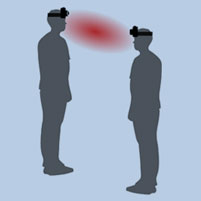Follow the Eyes

What is everyone looking at?
It's a common question in social settings because the answer identifies something of interest, or helps delineate social groupings.
Those insights someday will be essential for robots designed to interact with humans, so researchers at Carnegie Mellon University's Robotics Institute have developed a method for detecting where people's gazes intersect.
The researchers tested the method using groups of people with head-mounted video cameras. By noting where their gazes converged in three-dimensional space, the researchers could determine if they were listening to a single speaker, interacting as a group, or even following the bouncing ball in a ping-pong game.
The system thus uses crowdsourcing to provide subjective information about social groups that would otherwise be difficult or impossible for a robot to ascertain.
The researchers' algorithm for determining "social saliency" could ultimately be used to evaluate a variety of social cues, such as the expressions on people's faces or body movements, or data from other types of visual or audio sensors.
"This really is just a first step toward analyzing the social signals of people," said Hyun Soo Park, a Ph.D. student in mechanical engineering, who worked on the project with Yaser Sheikh, assistant research professor of robotics, and Eakta Jain of Texas Instruments, who was awarded a Ph.D. in robotics last spring.
"In the future, robots will need to interact organically with people and to do so they must understand their social environment, not just their physical environment."
Though head-mounted cameras are still unusual, police officers, soldiers, search-and-rescue personnel and even surgeons are among those who have begun to wear body-mounted cameras.
Head-mounted systems, such as those integrated into eyeglass frames, are poised to become more common.
Even if person-mounted cameras don't become ubiquitous, Sheikh noted that these cameras someday might be used routinely by people who work in cooperative teams with robots.
The research findings also suggest another possible application for monitoring gaze concurrence: player-level views of ball games.
Park said if basketball players all wore head-mounted cameras, for instance, it might be possible to reconstruct the game, not from the point of view of a single player, but from a collective view of the players as they all keep their eyes on the ball.
Another potential use is the study of social behavior, such as group dynamics and gender interactions, and research into behavioral disorders, such as autism.
Related Links: Project Website | Robotics Institute | School of Computer Science | College of Engineering | Assistive Robots | Robotics Excellence | Leading Autism Research
